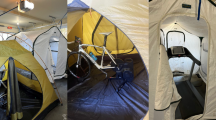Abstract
The purpose of this paper is both to define terms used in exercise physiology, i.e. anaerobic capacity, anaerobic work capacity and anaerobic potential, and develop a systems perspective of anaerobic capacity. Philosophical argument is used to support the proposed definitions and systems view, which is an approach to assist in the universal acceptance of such terms amongst scientific investigators, coaches and athletes, and provide a focus on physiological mechanisms associated with anaerobic capacity which may be the subject of future investigation.
Similar content being viewed by others
References
Åstrand P-O, Rodahl K (1977) Textbook of work physiology. Physiological bases of exercise. McGraw-Hill, New York
Bangsbø J, Gollnick PD, Graham TE, Juel C, Kiens B, Mizuno M, Saltin B (1990) Anaerobic energy production and O2 deficit-debt relationship during exhaustive exercise in humans. J Physiol (Lond) 422:439–559
Bennett AF (1978) Activity metabolism of the lower vertebrates. Annu Rev Physiol 400:477–479
Berg A, Jakob E, Keul J (1989) Physiological energetics in sports. In: Weiser W, Gnaiger E (eds) Energy transformations in cells and organisms. Thieme, Stuttgart, pp 241–247
Bouchard C, Taylor AW, Dulac S (1982) Testing maximal anaerobic power and capacity. In: MacDougall JD, Wenger HA, Green HJ (eds) Physiological testing of the elite athlete. Mouvement Publications, New York, pp 61–74
Camus G, Thys H (1991) An evaluation of the maximal anaerobic capacity in man. Int J Sports Med 12:349–355
di Prampero PE (1981) Energetics of muscular exercise. Rev Physiol Biochem Pharmacol 89:144–222
Donovan CM, Pagliassotti MJ (1990) Enhanced efficiency of lactate removal after endurance training. J Appl Physiol 68:1053–1058
Fox EL, Mathews DK (1981) The physiological basis of physical education and athletics. Saunders College Publishing, Philadelphia
Green S, Dawson B (1993) Measurement of anaerobic capacities in humans: definitions, limitations, and unsolved problems. Sports Med 15:312–327
Hill AV, Lupton H (1923) Muscular exercise, lactic acid, and the supply and utilization of oxygen. Q J Med 16:135–171
Juel C, Bangsbø, Graham T, Saltin B (1990) Lactate and potassium fluxes from human skeletal muscle during and after intense, dynamic, knee extensor exercise. Acta Physiol Scand 140:147–159
Kindermann W, Keul J (1977) Lactate acidosis with different forms of sporting activities. Can J Appl Sport Sci 2:177–182
Kowalchuk JM, Heigenhauser GJF, Lindinger MI, Sutton JR, Jones NL (1988) Factors influencing hydrogen ion concentration in muscle after intense exercise. J Appl Physiol 65:2080–2089
Mackova EV, Melichna J, Vondra K, Jurimae T, Paul T, Novak J (1985) Relationship between anaerobic performance and muscle metabolic capacity. Eur J Appl Physiol 54:413–415
Maison GL, Broeker AC (1941) Training in human muscle working with and without blood supply. Am J Physiol 132:390–404
Margaria R, Edwards HT (1934) The removal of lactic acid from the body during recovery from muscular exercise. Am J Physiol 107:681–686
Margaria R, Edwards HT, Dill DB (1933) The possible mechanism of contracting and paying the oxygen debt and the role of lactic acid in muscular contraction. Am J Physiol 106:689–714
Margaria R, Aghemo P, Rovelli E (1966) Measurement of muscular power (anaerobic) in man. J Appl Physiol 21:1662–1664
Medbø JI, Mohn AC, Tabata I, Bahr R, Vaage O, Sejersted OH (1988) Anaerobic capacity determined by maximal accumulated O2 deficit. J Appl Physiol 64:50–60
Needham DM (1971) The biochemistry of muscular contraction in its historical development. Cambridge University Press, London
Concise Oxford Dictionary (1983) Oxford University Press, Melbourne
Pate RR, Goodyear V, Dover J, Dorociak J, McDaniel JD (1983) Maximal O2 deficit: a test of anaerobic capacity. Med Sci Sports Exerc 15:121–122
Saltin B (1990) Anaerobic capacity: past, present, and prospective. In: Taylor AW, Gollnick PD, Green HJ, Ianuzzo CD, Noble EG, Metivier G, Sutton JR (eds) Biochemistry of exercise VII. International series on sport sciences, 21. Human Kinetics, Champaign, Ill., pp 387–412
Scherrer J, Samson M, Paleologue A (1954) Etudé du travail musculaire et de la fatigue. Données ergométriques obtenues chez l'homme. J Physiol (Paris) 46:887–916
Stewart PA (1981) How to understand acid-base. A quantitative acid-base primer for biology and medicine. Elsevier/North Holland, Amsterdam
Szogy A (1989) The influence of speed and strength characteristics on the anaerobic capacity of adolescent cyclists. In: Oseid S, Carlsen K-H (eds) Children and exercise XIII. International series on sport sciences. Human Kinetics, Champaign, Ill., pp 67–73
Walsh PJ, Milligan CL (1989) Coordination of metabolism and intracellular acid-base status: ionic regulation and metabolic consequences. Can J Zool 67:2994–3004
Webster N (1977) Webster's new twentieth century dictionary unabridged. Collins World, New York
Westra HG, Haan EJ de, Haan A de (1976) Quantitative aspects of the anaerobic capacity of perfused rat hind quarter. In: Landry F, Orban W (eds) Third International Symposium on Biochemistry of Exercise, 3. The International Congress of Physical Activity Sciences, Quebec, pp 345–354
Withers RT, Sherman WM, Clark DG, Esselbach PC, Nolan SR, Mackay MH, Brinkman M (1991) Muscle metabolism during 30, 60 and 90 s of maximal cycling on an air-braked ergometer. Eur J Appl Physiol 63:354–362
Author information
Authors and Affiliations
Rights and permissions
About this article
Cite this article
Green, S. A definition and systems view of anaerobic capacity. Europ. J. Appl. Physiol. 69, 168–173 (1994). https://doi.org/10.1007/BF00609411
Accepted:
Issue Date:
DOI: https://doi.org/10.1007/BF00609411




